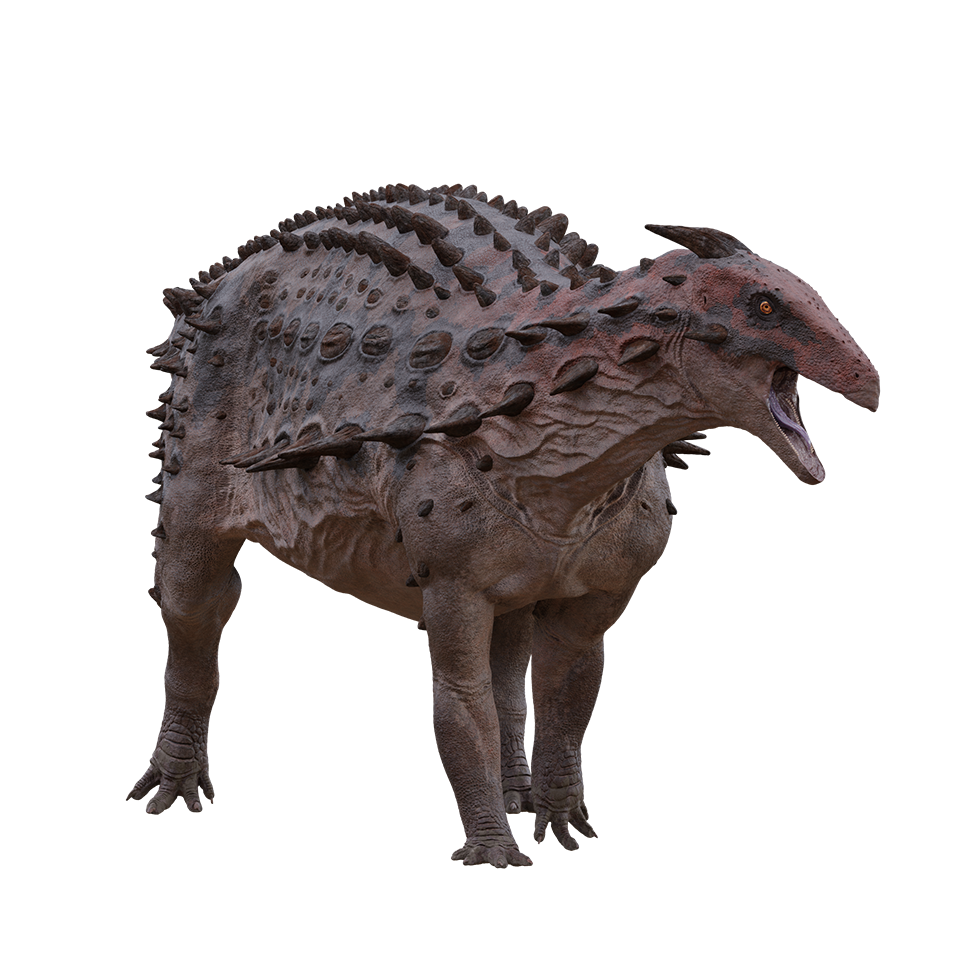The Armored Herbivore of the Great British Beach Rocks
This early relative of ankylosaurs and stegosaurs, discovered in the legendary fossil-rich rocks of the Dorset Coast, is the most completely known dinosaur from the British Isles, and the only classified dinosaur from Ireland!
Overview: 191 million years ago in the Early Jurassic of what is now England and Ireland, the medium-sized armored herbivore Scelidosaurus, a close relative of the stegosaurs and ankylosaurs, lived near the shore of the ancient Tethys Sea. First discovered in the mid-19th Century, it was one of the earliest dinosaur discoveries (the term dinosaur was coined only about 20 years earlier), and to this day is the most completely known dinosaur from the British Isles. As a somewhat advanced early thyreophoran, or armored dinosaur, Scelidosaurus offers insights into the evolution of stegosaurs and ankylosaurs.
Discovery: The first remains of Scelidosaurus were discovered by James Harrison in the 1850s in a quarry on the English Dorset Coast between Charmouth and Lyme Regis in rocks of the Charmouth Mudstone Formation which also produced famous fossils such as Ichthyosaurus, Plesiosaurus, and Dimorphodon. These bones were given to Henry Norris, who, in 1858, sent some of the bones to the early paleontologist Sir Richard Owen, the man who had coined the word “dinosaur” about 16 years earlier. In 1859, Owen named and described the fossils as Scelidosaurus. In 1861, after receiving additional fossils from Harrison, Owen published further description of Scelidosaurus, and named the species Scelidosaurus harrisonii, honoring James Harrison. In 1863, Owen described a nearly complete skeleton of the animal, and since then, additional Scelidosaurus fossils have been found in both England and Ireland, and currently Scelidosaurus is the most completely known dinosaur from the British Isles.
When Owen named Scelidosaurus, he intended its meaning to be “limb lizard”, because the original material he was given was from a hindlimb. However, what Scelidosaurus actually means is “rib lixzard” or “beef lizard”. This is because Owen got confused between the Greek words “skelos”, meaning “limb”, and “skelis”, meaning “rib” or “beef”. So instead of “limb lizard” he named the “rib/beef lizard”, which makes no sense, but the rules of scientific naming say the first name published for an animal is the one that sticks. And that’s why we still call it Scelidosaurus instead of the more accurate to Owen’s intentions “Scelodosaurus”.
Evolution: Scelidosaurus was an ornithischian (“bird-hipped”) dinosaur in the clade Thyreophora. Thyreophora is the clade of generally bulky armored herbivores that includes both Stegosauria and Ankylosauria. Scelidosaurus was an early thyreophoran that was more advanced than the smaller, bipedal Scutellosaurus which lived in North America a few million years earlier, but also not a member of either Stegosauria or Ankylosauria. It is thought to either be very close to the common ancestor of both stegosaurs and ankylosaurs, or a close relative of the first ankylosaurs, though not quite an ankylosaur itself. Either way, Scelidosaurus is an important animal for the understanding of the rise of thyreophorans, due to both its phylogenetic position, as well as its skeletal completeness which allows thorough study and comparison.
Description and Ecology: Scelidosaurus was a medium-sized herbivore which reached lengths of about 4 meters (13 ft) and weighed about 270 kg (600 lb). It had small armor plates in its skin called osteoderms which were arranged in three rows on each side of the torso. Compared to its ankylosaur relatives it was “lightly armored”. Between its osteoderms, skin impressions reveal that it had small, non-overlapping scales similar to a modern Gila monster lizard. Like later thyreophorans, it had a somewhat rotund body, a small head, and rather short legs. Scelidosaurus was probably mostly quadrupedal evidenced by its large body and its arms which are close to the same length as its legs, but fossil trackways suggest that it could also occasionally walk on just two legs. This may have helped it with feeding. Feeding on all fours would have limited its feeding height to just about a meter above the ground, but if it could rear up on its hind legs, then it could reach plants significantly higher. However, despite this, it is generally thought that it probably was mostly quadrupedal and most of its food probably grew close to the ground. Its possible occasional bipedalism was probably a fading holdover from more basal (“primitive”) thyreophorans like Scutellosaurus which would eventually disappear entirely in the stegosaurs and ankylosaurs.
Extinction and Legacy: Scelidosaurus lived in the early Jurassic as dinosaurs were diversifying and taking over the globe. But eventually it would be replaced by more advanced forms of thyreophorans. Stegosaurs became the dominant thyreophorans in the Jurassic, while ankylosaurs replaced them in the Cretaceous. Scelidosaurus can be found at several museums in the British Isles, including the British Natural History Museum in London, England, the Lyme Regis Museum in Lyme Regis, England, the Sedgwick Museum of Earth Sciences in Cambridge, England, the Bristol City Museum and Art Gallery in Bristol, England, and the Charmouth Heritage Coast Centre, in Charmouth, England, where a nearly complete skeleton can be seen along with a life reconstruction. For those in America who can’t make it to the British Isles, a replica of the Charmouth skeleton can be seen at the St. George Dinosaur Discovery Site at Johnson Farm in St. George, Utah, USA.
Scelidosaurus FAQ
Scelidosaurus size / How big was Scelidosaurus?
See height, weight, and length.
Scelidosaurus height / How tall was Scelidosaurus?
Scelidosaurus was around 1 meter (1.28 ft) tall.
Scelidosaurus weight / How much did Scelidosaurus weigh?
Scelidosaurus weighed about 270 kg (600 lb).
How long was Scelidosaurus?
Scelidosaurus was about 4 meters (13 ft) long.
What did Scelidosaurus eat?
Scelidosaurus ate low-growing plants.
What is Scelidosaurus closest living relative?
Like all dinosaurs, the closest relatives of Scelidosaurus are the only surviving lineage of dinosaurs today, the birds. Crocodilians, while not dinosaurs themselves, are also more distant cousins of dinosaurs.
Scelidosaurus family members / Scelidosaurus family / What kind of dinosaur was Scelidosaurus?
Scelidosaurus was an ornithischian (“bird-hipped dinosaur”) and an early member of the clade Thyreophora, making it an early relative of both stegosaurs and ankylosaurs.
Where did Scelidosaurus live? / Where was Scelidosaurus found?
Scelidosaurus lived in what is now England and Ireland.
When did Scelidosauruslive?
Scelidosaurus lived about 191 million years ago during the Early Jurassic Period.
What does Scelidosaurus mean? / Scelidosaurus name meaning
Scelidosaurus’s name came about because of a mix-up. Richard Owen intended the name to mean “limb lizard” (“Scelodosaurus”), but mixed up some Greek words, and gave it its name which means “rib lizard” or “beef lizard”.

